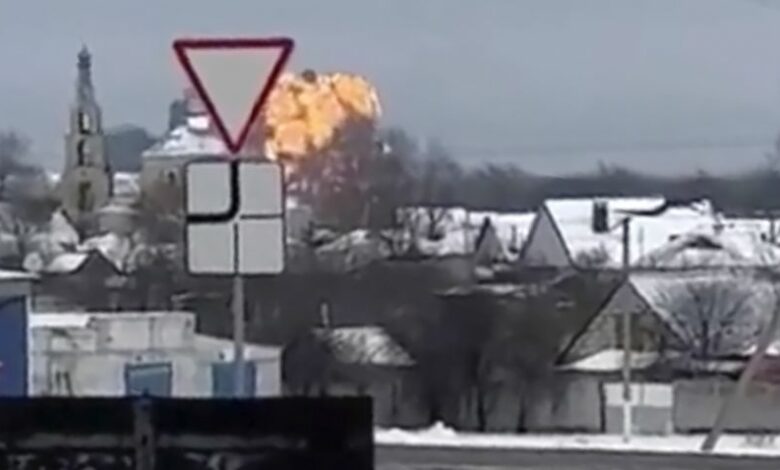
It’s still unclear why a Russian military transport aircraft crashed in the Belgorod region near the Ukraine border on Wednesday, whether because it was brought down by a missile or suffered some catastrophic technical failure. But all 74 people on board were killed, according to Russian authorities.
The first images of the wreckage on the ground are inconclusive; one video shows the last seconds of the plane as it hurtles towards earth before a large fireball erupts.
But the Russian authorities have claimed that Ukrainian missiles were responsible – and that they killed 65 of their own prisoners of war, along with six crew members and three Russian personnel, who were on board the Ilyushin Il-76.
The Russian Defense Ministry said the plane was destroyed by an anti-aircraft missile system deployed in the area of Liptsy in Ukraine’s Kharkiv region, some 50 miles (80 kilometers) from where the plane came down. It said radar equipment had detected the launches.
The Defense Ministry also claimed that “the Ukrainian leadership knew very well that, according to established practice, today Ukrainian military personnel would be transported by military transport aircraft to the Belgorod airfield for exchange” at the Kolotilovka checkpoint on the Russian border with the Ukrainian region of Sumy.
In response, Ukraine’s military command said it regarded Russian military aircraft approaching Belgorod as legitimate targets but stopped short of acknowledging it fired at a Russian transport plane.
The 50-mile distance from Liptsy to the crash site would be beyond most Ukrainian ground-to-air missile systems. A Ukrainian defense intelligence official did confirm that a prisoner exchange had been due to happen on Wednesday, but did not acknowledge knowing the logistical details of the Russian side of the swap. Another Ukrainian military source was quoted as claiming that the plane was carrying Russian missiles, not prisoners.
So one question is whether the Ukrainians were indeed aware of the timing and route of the aircraft that the Russians say was bringing prisoners to the site of the exchange, and additionally whether that information would have been conveyed to front-line units across the border from Belgorod.
But there are already other ramifications from this disaster.
Andrey Kartapolov, who is chairman of the Duma Defense Committee in Moscow, made a significant allegation in claiming that the missiles fired were from US-made Patriot or German-made IRIS-T systems that have been supplied to Ukraine, without offering any evidence. Ukraine has pledged not to use foreign-donated weapons to attack Russian territory and this would have been a highly significant departure from that policy. In any case, the IRIS-T would not have had the range to hit the Ilyushin from the nearest Ukrainian-held territory. A Patriot deployed (at considerable risk) so close to the border with Russia would have been within range of the plane.
Some observers are also pointing out that Russian missile defenses in the area were on high alert Wednesday, and that a Ukrainian drone had been brought down shortly before the plane crashed. However, the governor of Belgorod said that had happened in a location to the west of the city, which would put it at least 37 miles (60 kilometers) from the site where the Ilyushin crashed.
Another puzzling element is that according to the Russian version of events, the Ukrainian PoWs were guarded by just three Russian personnel on board the plane (besides the crew.) A former Ukrainian PoW, Maksym Kolesnikov, said Wednesday in a post on X that when he had been transported by plane from Bryansk to Belgorod, there were about 20 military police for 50 prisoners.
So this disaster already has multiple political dimensions and as yet a lot of unanswered questions. It has quickly become another episode in the information war that has been a constant in this conflict.
Dmytro Lubinets, Ukraine’s human rights ombudsman, said Wednesday that “information warfare is no less important than fighting at the front… The enemy is insidious. We all know what terrible methods Russia can use to destabilize Ukrainian society.”
Indeed the Russian Defense Ministry in its statement said that “by committing this terrorist attack, the Ukrainian leadership showed its true colors – it neglected the lives of its citizens.“
It’s worth recalling that Russia alleged that Ukraine killed its own prisoners of war in a strike on a camp in Olenivka in Donetsk 18 months ago, a claim that after extensive forensic investigation looked extremely dubious.
Then, as most likely in this instance, no independent on-the-ground analysis was possible.
But a large Russian military aircraft without anti-missile defenses approaching Belgorod – itself a frequent target of Ukrainian drones – would have been a tempting and valuable target for Ukraine.
It would therefore have been a flight of considerable risk – unless the Ukrainians had been notified of its purpose, as the Russians have claimed. On the whole, Russian Il-76 aircraft stay well beyond the range of Ukrainian missiles; this would be the first time since the full-scale Russian invasion of Ukraine nearly two years ago that one of them has been shot down.
But the Ukrainians have extended the range and frequency of their attacks into Russia, using drones, missiles and sabotage. Earlier this month, the Ukrainian military claimed to have shot down one of the Russians’ most advanced early detection aircraft, the A-50, over the Sea of Azov. There’s been no visual evidence of the wreckage, and the Russian Defense Ministry has not responded to the claim. Some analysts believe that the Ukrainians may have repurposed a Patriot battery to carry out that attack, but there has been no confirmation. Patriot missiles generally have a range of just under 100 miles.
For Ukraine, at a time when the battlefield is in stalemate and there are few victories to celebrate, attacking Russian bases, ships, aircraft and infrastructure well beyond the border has become a different way to disrupt the enemy’s military machine.
But if evidence emerges to confirm the version of events being offered up by the Russian Defense Ministry and others in Moscow, what would have been a coup for Ukrainian air defenses may instead have been a horrendous mistake.




